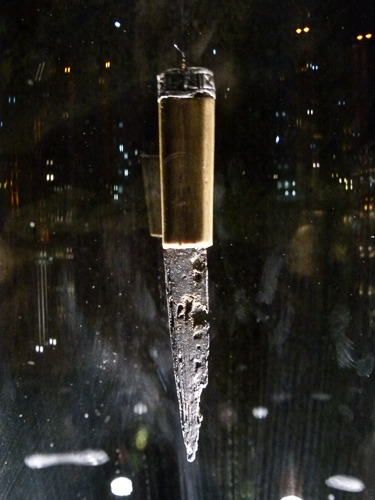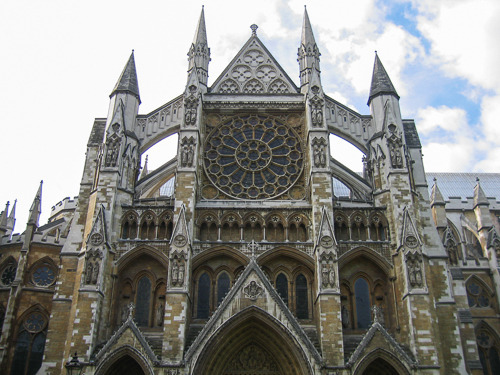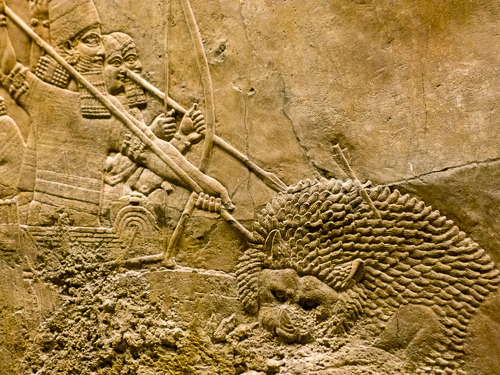Marie Brennan's Blog, page 175
January 22, 2014
A Year in Pictures – Ganesha at Halebidu


This work by http://www.swantower.com is licensed under a Creative Commons Attribution-NonCommercial-NoDerivatives 4.0 International License.
Ganesha is a popular Hindu deity, particularly known for his connection with obstacles, particularly the removal thereof. As such, you find images of him everywhere. This one was sitting somewhat randomly in the park behind the Halebidu temple in Kerala; it was not the only piece of sculpture that seemed to have been parked out there until the people maintaining the temple decided what to do with it.
Originally published at Swan Tower. You can comment here or there.
This entry was also posted at http://swan-tower.dreamwidth.org/610865.html. Comment here or there.
January 21, 2014
A Year in Pictures – Fushimi Inari Fountain
Fushimi Inari Fountain

This work by http://www.swantower.com is licensed under a Creative Commons Attribution-NonCommercial-NoDerivatives 4.0 International License.
Shrines in Japan have fountains at which you are expected to purify yourself (by pouring water over your hands at a minimum). Some of them are pretty plain, but others — such as this one at Fushimi Inari — are sculpted in awesome ways. Inari, being associated with foxes, naturally gets a fox fountain.
Originally published at Swan Tower. You can comment here or there.
This entry was also posted at http://swan-tower.dreamwidth.org/610601.html. Comment here or there.
January 20, 2014
A question for the legal eagles
More a question for the legislative eagles, I suppose. This has nothing to do with the Memoirs of Lady Trent; it’s a question for the modern-day U.S. (Because when I’m on the home stretch of a book is a great time for totally unrelated stories to mug me!)
Suppose there is a federal law to deal with Topic X. Ambiguous Situation B arises, sparking disagreement over whether the law applies in this instance or not. This is the first time Ambiguous Situation B has occurred, but it likely won’t be the last, and Topic X is a pretty serious issue, so people are very invested in getting the matter settled beyond question.
Quite apart from the fact that there would be presumably be a legal brangle over the applicability or irrelevance of Law for Topic X, I imagine that there would also be a rush to amend the law and render that question permanently moot.
My question for you all: how would this proceed?
Assume that Congress is very interested in getting the law amended ASAP, but that it is divided as to whether it should be amended to say “nope, definitely doesn’t apply here” or “hell yes it applies.” Would there be competing bills, one for each side? (I imagine there would.) Different bills in the House and the Senate? How do those get started? What process do they go through before they come to a vote? How rapidly could all of this unfold, presuming there is a compelling reason for trying to make it happen quickly? How would Congress deal with there being two bills in direct opposition to one another, if that’s actually what would be going on? What effect would the ongoing legal brangle have on the legislative process? (The lawsuit being settled in favor of “yes, it applies” could theoretically render unnecessary any change to say that yes, it applies, but Congress is now worried about the possibility of Ambiguous Situations C, D, E, and everything else they can think up. And if the lawsuit gets settled the other way, the side that wants Ambiguous Situation B covered could say “well, we just changed the law, and this version definitely applies.”)
I know only slightly more than zilch about the legislative process in this country, so this is one of those “talk to me like I’m five” questions. I need to know the procedure here before I can judge what it would do to the rest of the story.
Originally published at Swan Tower. You can comment here or there.
This entry was also posted at http://swan-tower.dreamwidth.org/610358.html. Comment here or there.
Things They Do Not Teach You in Writer School, #17
So as I mentioned before, I think this book is going to run a little long.
How exactly do I know that?
Nobody ever talks about this in books of writing advice, at least not that I’ve ever seen. Nor have I heard it being discussed in creative writing classes (though if your teacher taught you this, I’d love to hear about it). We all know writers need a variety of skills, things like characterization and plotting and the ability to string together an interesting sentence . . . but nobody talks about how you learn to tell how much story you’ve got in your hand.
I thought of this because I was doing some calculations, trying to figure out how hard I would need to drive myself to get a draft done by the end of the month. It’s a little tricky, doing that math when you don’t actually know what goes on the other side of the equal sign. I knew I couldn’t fit the remaining plot into ten thousand words; fine, that means I’ll overrun my target length of 90K. By how much? Not sure. Well, okay: if I wrote two thousand words a day instead of one thousand, then I could write 26K by the end of the month. Ooof, no, way overkill — there’s no way this is 26K of plot remaining. Somewhere between 10 and 26. 15-ish, maybe? That sounds about right . . . .
How do I know this? I can’t even really tell you. I am not the sort of writer who says “this chapter will consist of four scenes, two of them one thousand words long and the other two five hundred.” The scenes are as long as they need to be to get the job done, and I find out how long that is by writing them. I keep forgetting to put in chapter breaks, because for four years I wrote Onyx Court novels that didn’t have any; now I go back and drop them in wherever there’s an appropriate point within a certain range of wordcount. But I can only forecast by approximation: can I get Isabella off Lahaui in a thousand words? Definitely not. Two thousand? Ehhhh, maybe . . . (Verdict as of tonight’s writing: nope, definitely not.) I won’t need five thousand, that’s for damn sure. Somewhere between 2 and 5.
I have to do this all book long. I want to write a 90K book; that means I need to be able to judge how much stuffing goes into the sausage. I sort of weigh it in my hand as I go, looking at the casing, trying to decide whether I should pack more in or not. Eventually I start to feel like okay, we’re at the point now where it’s time to pull things together and wrap them up, rather than adding in new stuff. Within a certain margin of error, I’m right. (When Ashes ran 30K long, I saw that coming a mile off. I hadn’t even finished writing Part One when I e-mailed my editor to say, we’re gonna need a bigger boat.)
Nobody taught me how to do this. I don’t know if it can be taught, because the answers can vary so much from writer to writer. What one person knocks off in five hundred words, another might spend two thousand on. Even if you’re the sort who outlines ahead of time instead of making it up as you go along, you need a sense for how many words it will take you to say something. And I’m not sure how you acquire that sense, other than by writing a lot and seeing how many words you end up with.
All of which is just sort of me rambling, because wordcount has been on my brain lately. But it’s one of those things I never really see discussed — a skill nobody tells you you’ll have to acquire.
Originally published at Swan Tower. You can comment here or there.
This entry was also posted at http://swan-tower.dreamwidth.org/610059.html. Comment here or there.
A Year in Pictures – Assyrian Lion Hunt
Assyrian Lion Hunt

This work by http://www.swantower.com is licensed under a Creative Commons Attribution-NonCommercial-NoDerivatives 4.0 International License.
I feel rather bad for the lions in these murals (which are hung in the British Museum). But the murals themselves are splendid: a whole series of Assyrian works, depicting warfare and a royal lion hunt, full of action and excitement. They aren’t easy to photograph — the images run on continually, making it hard to choose a useful framing — but the diagonal line of this one worked out well, I think.
Originally published at Swan Tower. You can comment here or there.
This entry was also posted at http://swan-tower.dreamwidth.org/609852.html. Comment here or there.
January 19, 2014
I knew this was coming
Oh god, book. You’re going to run long, aren’t you?
Of course you’re going to run long. We’re at eighty thousand words, and Isabella has only just reached Lahaui. There’s still [spoiler] to recognize, [spoiler] to steal (again), [more spoilers] to find, and then [great big spoiler] before we can have our denoument. I don’t think I’m going to manage that in the next ten thousand words.
. . . bugger.
Has any author anywhere in the world ever written a series that got shorter as it went along? (Probably.) But the natural tendency of series seems to be to acquire a few thousand extra words here, a few thousand there, as you get more accustomed to the characters and the setting and find more interesting (and complex) (and wordy) things to do with them.
Oh well. I suppose I should just be glad this isn’t In Ashes Lie, running thirty thousand words over my original estimate. NEVER. AGAIN.
131 more words to go tonight, and then I can stop. Because three 3K days in a row is fun! >_<
(Actually, it kind of is. But only because I’m filling those 3K wodges with pulp-tastic adventurey goodness.)
Originally published at Swan Tower. You can comment here or there.
This entry was also posted at http://swan-tower.dreamwidth.org/609624.html. Comment here or there.
January 17, 2014
A Year in Pictures – Fukusaiji Turtle Head


This work by http://www.swantower.com is licensed under a Creative Commons Attribution-NonCommercial-NoDerivatives 4.0 International License.
A lot of temples in Japan are built on a traditional format, involving lots of wood and ribbed roof tiles and the usual thing you see in photos. Every so often, though, you find one that’s . . . different. Like this one, where the roof is carved to look like a giant turtle, with Kannon riding its back and a bunch of children looking up at her adoringly. This is the head of that turtle, and it’s really just . . . odd, man. 
Originally published at Swan Tower. You can comment here or there.
This entry was also posted at http://swan-tower.dreamwidth.org/609412.html. Comment here or there.
January 16, 2014
A Year in Pictures – Sloop at Sea


This work by http://www.swantower.com is licensed under a Creative Commons Attribution-NonCommercial-NoDerivatives 4.0 International License.
I’ve had a soft spot for sailing ever since I went on a trip with my family and some family friends to the British Virgin Islands. We chartered a 40′ sloop and went sailing around for about a week, I think, and I’ve never forgiven myself for being nine at the time and not appreciating it the way I would now.  Anyway, this photo was taken off the coast of O’ahu, and really, it’s all about the light.
Anyway, this photo was taken off the coast of O’ahu, and really, it’s all about the light.
Originally published at Swan Tower. You can comment here or there.
This entry was also posted at http://swan-tower.dreamwidth.org/609097.html. Comment here or there.
January 15, 2014
A Year in Pictures – Polish Knife


This work by http://www.swantower.com is licensed under a Creative Commons Attribution-NonCommercial-NoDerivatives 4.0 International License.
Redevelopment in the main market square of Krak#oacute;w turned into a massive archaeological dig which was eventually conserved as an underground museum. This knife is one of a huge number of items on display. Although ordinarily I consider reflections in the glass to be a flaw in a museum photo, in this case I liked the starry effect it creates around the knife.
Originally published at Swan Tower. You can comment here or there.
This entry was also posted at http://swan-tower.dreamwidth.org/608783.html. Comment here or there.
January 14, 2014
A Year in Pictures – Westminster Abbey


This work by http://www.swantower.com is licensed under a Creative Commons Attribution-NonCommercial-NoDerivatives 4.0 International License.
You can’t take photographs inside most of Westminster Abbey, and the exterior is hard to capture because of the sheer size. But on my research trip for Midnight Never Come I gave it the old college try. This is the north entrance, where you purchase admission and audio guides, and I have an odd fondness for the patchwork appearance of the stone — not to mention a general love of Gothic architecture in the first place.
Originally published at Swan Tower. You can comment here or there.
This entry was also posted at http://swan-tower.dreamwidth.org/608734.html. Comment here or there.





